A Machine Learning Model for Torsion Strength of Externally Bonded FRP-Reinforced Concrete Beams
Abstract
:1. Introduction
2. Experimental Database Profiles
3. Brief Summaries of Previous Models
3.1. FIB
3.2. Deifalla
3.3. ACI
4. Effects of Significant Parameters on Torsion Gain
5. Machine Learning Models
- Dividing the database into training and test sets.
- Applying the training methodology for the training set.
- Checking the accuracy requirements.
- Output the predicted values.
5.1. Ensembled Trees
5.2. Gaussian Process Regression
5.3. Neural Networks
5.4. Results and Discussions
6. Comparison between Proposed Model and Existing Design Models
7. Summary and Conclusions
- -
- The proposed model based on wide neural networks provides good accuracy and reliable representation of the behavior.
- -
- The most dominant input parameter is effective depth, followed by an FRP reinforcement ratio and then strengthening scheme, while fiber orientation has proven to have the least effect on the prediction output accuracy.
- -
- This study could help further design code development.
Author Contributions
Funding
Institutional Review Board Statement
Informed Consent Statement
Data Availability Statement
Conflicts of Interest
References
- Whittle, R. Failures in Concrete Structures—Case Studies in Reinforced and Prestressed Concrete; FL 33487-2742; CRC Press: Boca Raton, FL, USA; Taylor & Francis Group: Abingdon, UK, 2013; 140p. [Google Scholar]
- Xian, G.; Guo, R.; Li, C. Combined effects of sustained bending loading, water immersion and fiber hybrid mode on the mechanical properties of carbon/glass fiber reinforced polymer composite. Compos. Struct. 2022, 281, 115060. [Google Scholar] [CrossRef]
- Chenggao, L.; Guijun, X.; Hui, L. Tension-tension fatigue performance of a large-diameter pultruded carbon/glass hybrid rod. Int. J. Fatigue 2019, 120, 141–149. [Google Scholar] [CrossRef]
- Rui, G.; Guijun, X.; Chenggao, L.; Xiangyu, H.; Meiyin, X. Effect of fiber hybridization types on the mechanical properties of carbon/glass fiber reinforced polymer composite rod. Mech. Adv. Mater. Struct. 2021. [Google Scholar] [CrossRef]
- Mohammed, A.A.; Manalo, A.C.; Ferdous, W.; Zhuge, Y.; Vijay, P.; Pettigrew, J. Experimental and numerical evaluations on the behaviour of structures repaired using prefabricated FRP composites jacket. Eng. Struct. 2020, 210, 110358. [Google Scholar] [CrossRef]
- Siddika, A.; Mamun, M.A.A.; Ferdous, W.; Alyousef, R. Performances, challenges, and opportunities in strengthening reinforced concrete structures by using FRPs—A state-of-the-art review. Eng. Fail. Anal. 2020, 111, 104. [Google Scholar] [CrossRef]
- American Concrete Institute. ACI 440.2R-17; Guide for the Design and Construction of Externally Bonded FRP Systems for Strengthening Concrete Structures. American Concrete Institute: Farmington Hills, MI, USA, 2017.
- FIB. FRP Reinforcement in RC Structures; Technical Report Prepared by a Working Party of Task Group 9.3; FIB Bulletin 40; International Federation for Structural Concrete: Lausanne, Switzerland, 2007; p. 151. [Google Scholar]
- CSA-S806-02; Design and Construction of Building Components with Fiber Reinforced Polymers. Canadian Standards Association: Rexdale, ON, Canada, 2002; 206p.
- American Concrete Institute. ACI 440.2R-08; Guide for the Design and Construction of Externally Bonded FRP Systems for Strengthening Concrete Structures. American Concrete Institute: Farmington Hills, MI, USA, 2008.
- Gosbell, T.; Meggs, R. West gate bridge approach spans FRP strengthening Melbourne. In Proceedings of the IABSE Symposium, Melbourne, Australia, 11–13 September 2002. [Google Scholar]
- Deifalla, A.F.; Zapris, A.G.; Chalioris, C.E. Multivariable Regression Strength Model for Steel Fiber-Reinforced Concrete Beams under Torsion. Materials 2021, 14, 3889. [Google Scholar] [CrossRef]
- Deifalla, A. Refining the Torsion Design of Fibered Concrete Beams Reinforced with FRP using Multi-variable Non-linear Regression Analysis for Experimental Results. Eng. Struct. 2020, 224, 111394. [Google Scholar] [CrossRef]
- Deifalla, A. Torsion Design of Lightweight Concrete Beams without or with Fibers: A comparative study and a refined cracking torque formula. Structures 2020, 28, 786–802. [Google Scholar] [CrossRef]
- Deifalla, A.; Awad, A.; Seleem, H.; AbdElrahman, A. Investigating the Behavior of Lightweight Foamed Concrete T-Beams under Torsion, shear, and Flexure. Eng. Struct. 2020, 219, 110741. [Google Scholar] [CrossRef]
- Deifalla, A.; Awad, A.; Seleem, H.; AbdElrahman, A. Experimental and numerical investigation of the behavior of LWFC L-girders under combined torsion. Structures 2020, 26, 362–377. [Google Scholar] [CrossRef]
- Deifalla, A.; Ghobarah, A. Behavior and Analysis of Inverted T-shaped RC Beams under Shear and Torsion. Eng. Struct. 2014, 62, 776–786. [Google Scholar] [CrossRef]
- Hassan, M.M.; Deifalla, A. Evaluating the new CAN/CSA-S806-12 torsion provisions for concrete beams with FRP reinforcements. Mater. Struct. 2016, 49, 2715–2729. [Google Scholar] [CrossRef]
- Deifalla, A. Torsional Behavior of Rectangular and Flanged Concrete Beams with FRP Reinforcements. J. Struct. Eng. 2015, 141, 04015068. [Google Scholar] [CrossRef]
- Deifalla, K.M.S.; Abdelrahman, A. Simplified Model for the Torsional Strength of Concrete Beams with GFRP Stirrups. J. Compos. Constr. 2015, 19, 04014032. [Google Scholar] [CrossRef]
- Deifalla, A.; Hamed, M.; Saleh, A.; Ali, T. Exploring GFRP bars as reinforcement for rectangular and L-shaped beams subjected to significant torsion: An experimental study. Eng. Struct. 2014, 59, 776–786. [Google Scholar] [CrossRef]
- Deifalla, A.; Awad, A.; El-Garhy, M. Effectiveness of Externally Bonded CFRP Strips for Strengthening Flanged Beams under Torsion: An Experimental Study. Eng. Struct. 2013, 56, 2065–2075. [Google Scholar] [CrossRef]
- Deifalla, A.; Ghobarah, A. Strengthening RC T-Beams Subjected to Combined Torsion and Shear Using FRP fabrics—Experimental study. Compos. Constr. 2010, 14, 301–311. [Google Scholar] [CrossRef]
- Saeed Atea, R. Torsional behavior of reinforced concrete T-beams strengthened with CFRP strips. Case Stud. Constr. Mater. 2017, 7, 110–127. [Google Scholar]
- Siddikaa, A.; Abdullah-Al-Mamun, M.; Alyousefc, R.; Amran, Y.H.M. Strengthening of reinforced concrete beams by using fiber-reinforced polymer composites: A review. J. Build. Eng. 2019, 25, 100798. [Google Scholar] [CrossRef]
- Alabdulhady, M.; Sneed, L.H. Torsional strengthening of reinforced concrete beams with externally bonded composites: A state of the art review. Constr. Build. Mater. 2019, 205, 148–163. [Google Scholar] [CrossRef]
- Deifalla, A.; Ghobarah, A. Simplified analysis of RC beams torsionaly strengthened using FRP. In Proceedings of the International Symposium on Bond Behavior of FRP in Structures, BBFS 2005, Hong Kong, China, 7–9 December 2005. [Google Scholar]
- Deifalla, A.; Ghobarah, A. Calculating the Thickness of FRP Jacket for Shear and Torsion strengthening of RC T-Girders. In Proceedings of the Third International Conference on FRP Composites in Civil Engineering, Miami, FL, USA, 13–15 December 2006. [Google Scholar]
- Deifalla, A.; Ghobarah, A. Full torsional behavior of RC beams wrapped with FRP: Analytical model. Compos. Constr. 2010, 14, 289–300. [Google Scholar] [CrossRef]
- Karayannis, C.G.; Kosmidou, P.-M.K.; Chalioris, C.E. Reinforced Concrete Beams with Carbon-Fiber-Reinforced Polymer Bars—Experimental Study. Fibers 2018, 6, 99. [Google Scholar] [CrossRef] [Green Version]
- Al-Bayati, G.; Al-Mahaidi, R. Torsional Strengthening of Concrete Members Using CFRP Composites: A State-of-the-Art Review. In Proceedings of the Fourth Asia-Pacific Conference on FRP in Structures (APFIS 2013), Melbourne, Australia, 11–13 December 2013; International Institute for FRP in Construction: Kingston, ON, Canada, 2013. [Google Scholar]
- Salem, N.M.; Deifalla, A. Evaluation of the Strength of Slab–Column Connections with FRPs Using Machine Learning Algorithms. Polymers 2022, 14, 1517. [Google Scholar] [CrossRef] [PubMed]
- Ebid, A.; Deifalla, A. Using Artificial Intelligence Techniques to Predict Punching Shear Capacity of Lightweight Concrete Slabs. Materials 2022, 15, 2732. [Google Scholar] [CrossRef]
- Ebid, A.; Deifalla, A. Prediction of Shear Strength of FRP Reinforced Beams with and Without Stirrups Using (GP) Technique. Ain Shams Eng. J. 2021, 12, 2493–2510. [Google Scholar] [CrossRef]
- Chalioris, C.E.; Karayiannis, C. Effectiveness of the use of steel fibres on the torsional behavior of flanged concrete beams. Cem. Concr. Compos. 2009, 31, 331–341. [Google Scholar] [CrossRef]
- Kalfat, R.; Al-Mahaidi, R.; Smith, S. Anchorage devices used to improve the performance of reinforced concrete beams retrofitted with FRP composites: State-of-the-art review. J. Compos. Constr. 2013, 17, 14–33. [Google Scholar] [CrossRef]
- Zhang, J.; Lu, T.; Zhu, H. Experimental study on the behavior of RC torsional members externally bonded with CFRP. In Proceedings of the FRP Composites in Civil Engineering Conference, Hong Kong, China, 12–15 December 2001; Elsevier Science Ltd.: Amsterdam, The Netherlands, 2001; Volume I. [Google Scholar]
- Biddah, A.; El-Behairy, S.; Hussein, S. Repair and strengthening of bridge concrete beams subjected to shear and torsion using FRP. In Proceedings of the 6th International Conference on Short and Medium Span Bridges, Vancouver, BC, Canada, 31 July–2 August 2002. [Google Scholar]
- Ghobarah, M.; Ghorbel, C.S. Upgrading torsional resistance of RC beams using FRP. J. Compos. Constr. 2002, 6, 257–263. [Google Scholar] [CrossRef]
- Panchacharam, S.; Belarbi, A. Torsional behavior of reinforced concrete beams strengthened with FRP composites. In Proceedings of the First FIB Congress on Concrete Structures in the 21st Century, Osaka, Japan, 13–19 October 2002. [Google Scholar]
- Sharobim, K.; Mokhtar, H. Behavior of retrofitted concrete beams using carbon fiber reinforced plastics under torsion. In Proceedings of the Structural Composites for Infrastructure Application, Aswan, Egypt, 17–20 December 2002. [Google Scholar]
- Ronagh, H.R.; Dux, P.F. Full-scale torsion testing of concrete beams strengthened with CFRP. In Proceedings of the 1st International Conference on the Performance of Construction Materials in the New Millennium, Cairo, Egypt, 18–20 February 2003; pp. 735–743. [Google Scholar]
- Salom, P.; Gergely, J.; Young, D. Torsional strengthening of spandrel beams with fiber-reinforced polymer laminates. J. Compos. Constr. 2004, 8, 157–162. [Google Scholar] [CrossRef]
- Sayed, M. Strengthening of Reinforced Concrete Beams in Torsion. Master’s Thesis, Structural Engineering, Faculty of Engineering, El Zag-Zig University, Zagazig, Egypt, 2004. [Google Scholar]
- He, H.; Kiyomiya, O.; Masuda, A. Experimental Study on Torsion Behaviour of PC Beams Strengthened with Carbon Fiber Sheets. Eng. Concr. 2004, 26, 4. Available online: http://data.jci-net.or.jp/search.shtml (accessed on 5 March 2022).
- Hii, A.K.Y.; Al-Mahaidi, R. An Experimental and numerical investigation on torsional strengthening of solid and box-section RC beams using CFRP laminates. Compos. Struct. 2006, 75, 213–221. [Google Scholar] [CrossRef]
- Ameli, M.; Ronagh, H.; Dux, P. Behavior of FRP strengthened concrete beams under torsion. J. Compos. Constr. 2007, 11, 192–200. [Google Scholar] [CrossRef]
- Genidi, M. Strengthening of Reinforced Concrete Beams in Shear and Torsion Using Composite Materials. Ph.D. Thesis, Structural Engineering, Faculty of Engineering, Helwan University, Cairo, Egypt, 2007. [Google Scholar]
- Chalioris, C.E. Torsional strengthening of rectangular and flanged beams using carbon fiber-reinforced-polymers—Experimental study. Constr. Build. Mater. 2008, 22, 21–29. [Google Scholar] [CrossRef]
- Mohammadizadeh, M.; Fadeel, M.; Ronagh, H.R. Improving Torsional behavior of reinforced concrete beams strengthened with carbon fibre reinforced polymer composite. Iran. Polym. J. 2009, 18, 315–327. [Google Scholar]
- Natarajan, A.; Kumar, P.A. Experimental investigation of torsional behaviour of glass fibre wrapped reinforced concrete beam. Int. J. Earth Sci. Eng. 2009, 2, 63–67. [Google Scholar]
- Mohammadizadeh, M.; Fadeel, M. Experimental investigation on torsional strengthening of high strength concrete beams using CFRP sheets. Kuwait J. Sci. Eng. 2010, 37, 1–19. [Google Scholar]
- Mahmood, A.S.; Mahmood, M. Torsional behavior of prestressed concrete beams strengthened with CFRP sheets. In Proceedings of the 16th International Conference on Composite Structures (ICCS 16), Porto, Portugal, 28–30 June 2011. [Google Scholar]
- Abduljalil, A.S.; Sarsam, K.F. Torsional Behavior of Reinforced Concrete T Beams Strengthened with CFRP Strips. Eng. Technol. J. 2012, 30, 1462–1482. [Google Scholar]
- Chhabirani, T. Study of Torsional Behaviour of Rectangular Reinforced Concrete Beams Wrapped with GFRP. Master’s Thesis, National Institute of Technology, Odisha, India, 2012. [Google Scholar]
- El-Kateb, M.M.; Abdel Rahman, A.A.; Hassan, T.K. Torsional Strengthening of Reinforced Concrete Beams Using CFRP Sheets. Civ. Eng. Res. Mag. 2013, 35, 10. [Google Scholar]
- Khanna, S.; Patra, K. Torsional Strengthening of R.C. Beams Using Glass Fibre Reinforced Polymers (GFRP). IJERT 2013, 2, 1873–1878. [Google Scholar]
- Jariwala, V.H.; Patel, H.P.V.; Purohit, S.P. Strengthening of RC beams subjected to combined torsion and bending with GFRP composites. Procedia Eng. 2013, 51, 282–289. [Google Scholar] [CrossRef] [Green Version]
- Salem, N.M.F. A Survey on Various Image Inpainting Techniques. Future Eng. J. 2021, 2, 1. [Google Scholar]
- Salem, N.M.; Mahdi, H.M.K.; Abbas, H.M. A Novel Face Inpainting Approach Based on Guided Deep Learning. In Proceedings of the 4th International Conference on Communications, Signal Processing, and their Applications (ICCSPA), virtual, 16–18 March 2021. [Google Scholar]
- Salem, N.M.; Mahdi, H.M.K.; Abbas, H.M. Random-Shaped Image Inpainting using Dilated Convolution. Int. J. Eng. Adv. Technol. IJEAT 2019, 8, 641–647. [Google Scholar] [CrossRef]
- Salem, N.M.; Mahdi, H.M.K.; Abbas, H.M. Semantic image inpainting using self-learning encoder-decoder and adversarial loss. In Proceedings of the 13th International Conference on Computer Engineering and Systems (ICCES), Cairo, Egypt, 18–19 December 2018; pp. 103–108. [Google Scholar]
- Geetha, N.K.; Bridjesh, P. Overview of machine learning and its adaptability in mechanical engineering. Mater. Today 2020. [Google Scholar] [CrossRef]
- Mangalathu, S.; Karthikeyan, K.; De-Cheng, F.; Jeon, J.-S. Machine-learning interpretability techniques for seismic performance assessment of infrastructure systems. Eng. Struct. 2022, 250, 112883. [Google Scholar] [CrossRef]
- Chen, S.-Z.; Feng, D.-C.; Han, W.-S.; Wub, G. Development of data-driven prediction model for CFRP-steel bond strength by implementing ensemble learning algorithms. Constr. Build. Mater. 2021, 303, 124470. [Google Scholar] [CrossRef]
- Mangalathu, S.; Shin, H.; Choi, E.; Jeon, J.S. Explainable machine learning models for punching shear strength estimation of flat slabs without transverse reinforcement. J. Build. Eng. 2021, 39, 102300. [Google Scholar] [CrossRef]
- Alotaibi, E.; Mostafa, O.; Nassif, N.; Omar, M.; Arab, M.G. Prediction of Punching Shear Capacity for Fiber-Reinforced Concrete Slabs Using Neuro-Nomographs Constructed by Machine Learning. J. Struct. Eng. 2021, 147, 04021075. [Google Scholar] [CrossRef]
- Kumar, P.; Lai, S.; Wong, J.; Mohd, N.; Kamal, M.; Afan, H.A.; Ahmed, A.; Sherif, M.; Sefelnasr, A.; El-Shafie, A. Review of nitrogen compounds prediction in water bodies using artificial neural networks and other models. Sustainability 2020, 12, 4359. [Google Scholar] [CrossRef]

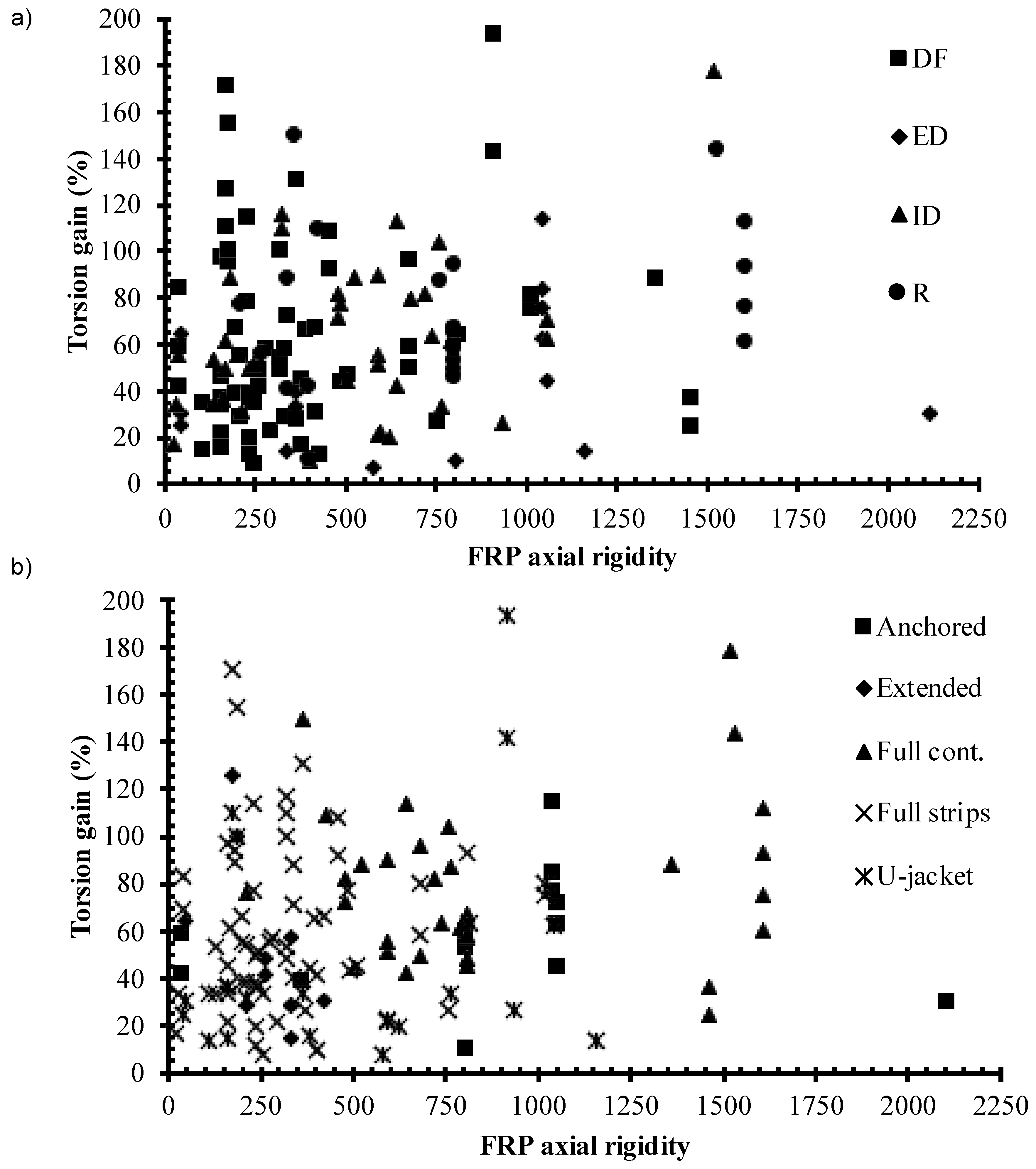

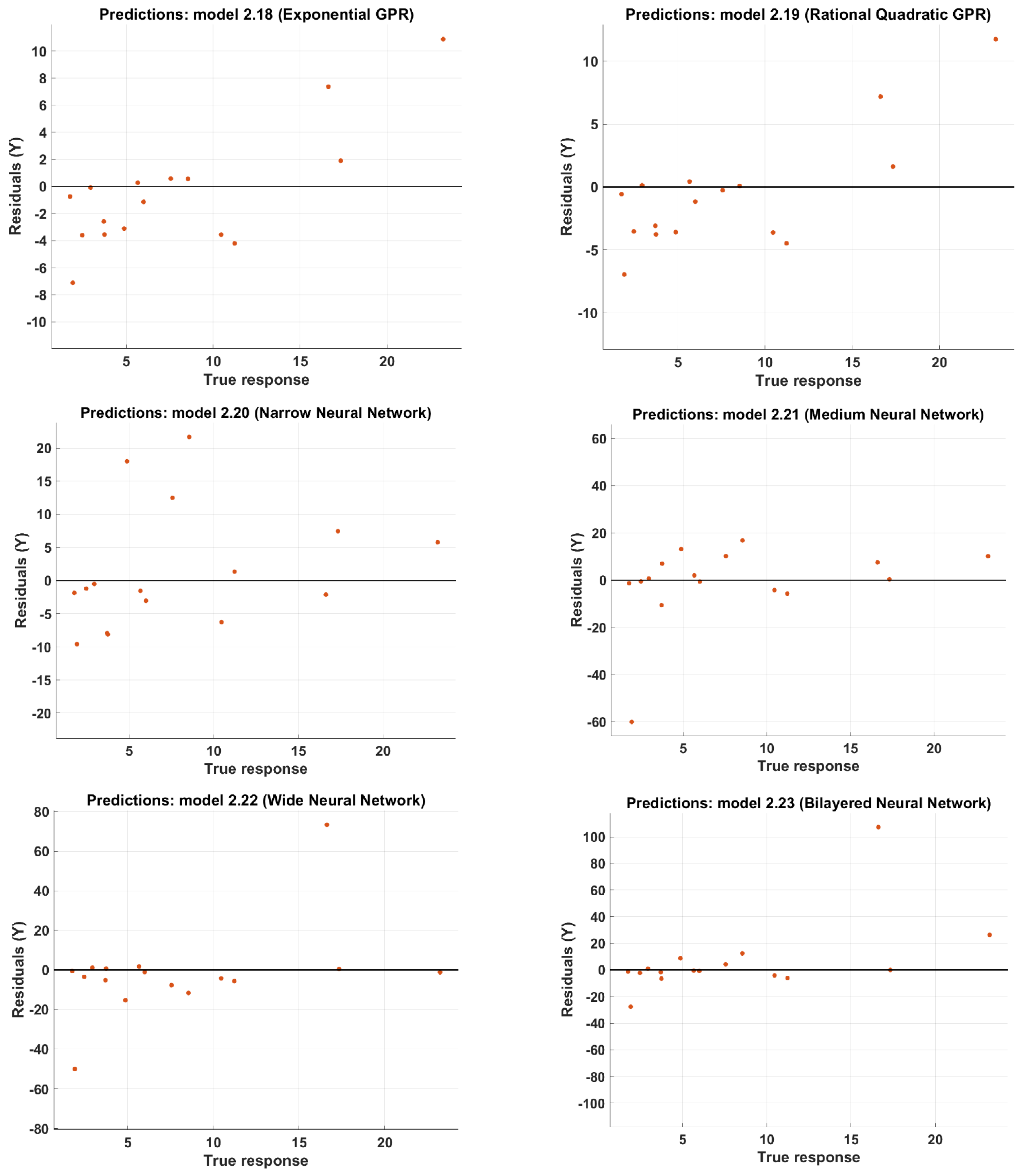
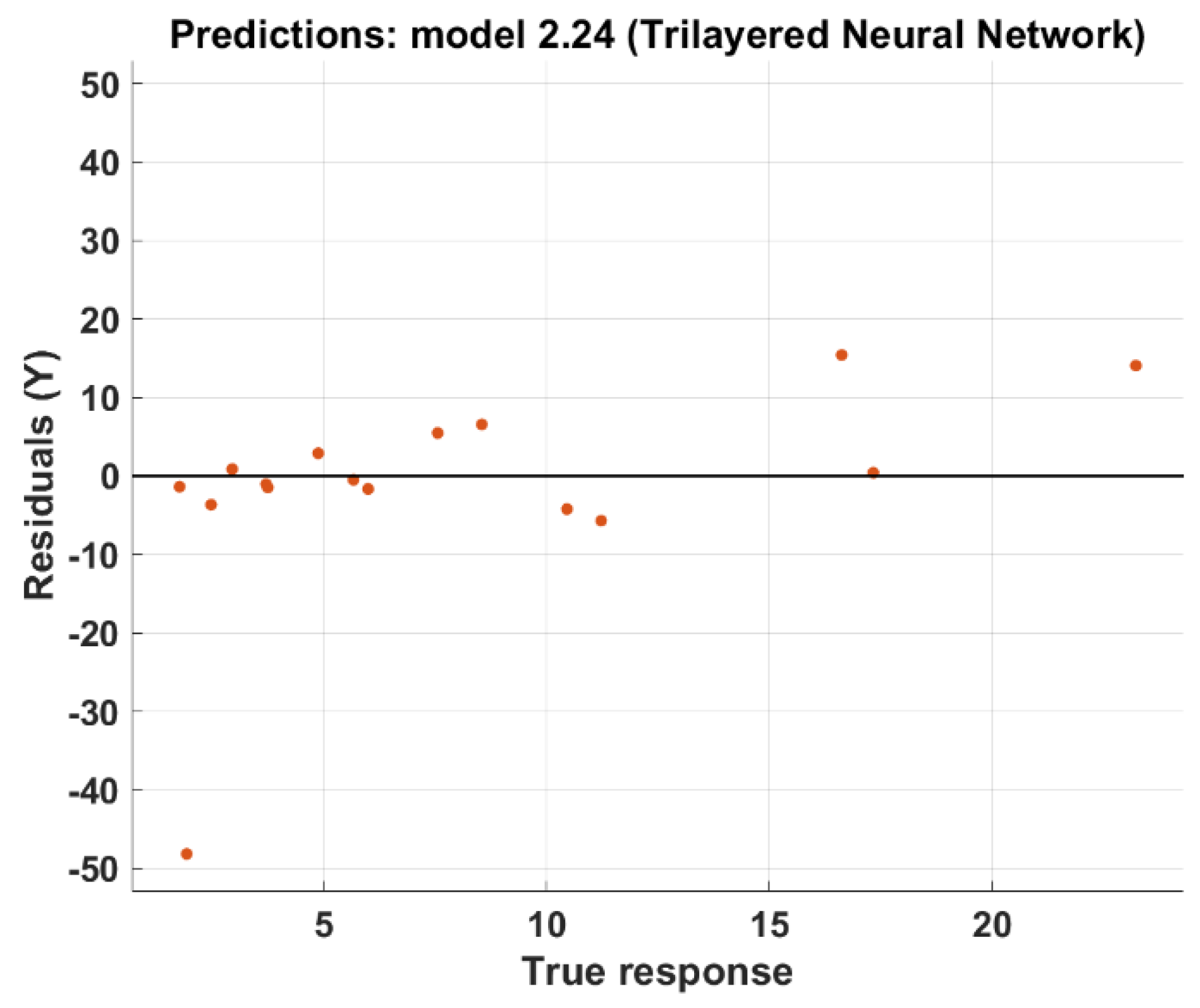


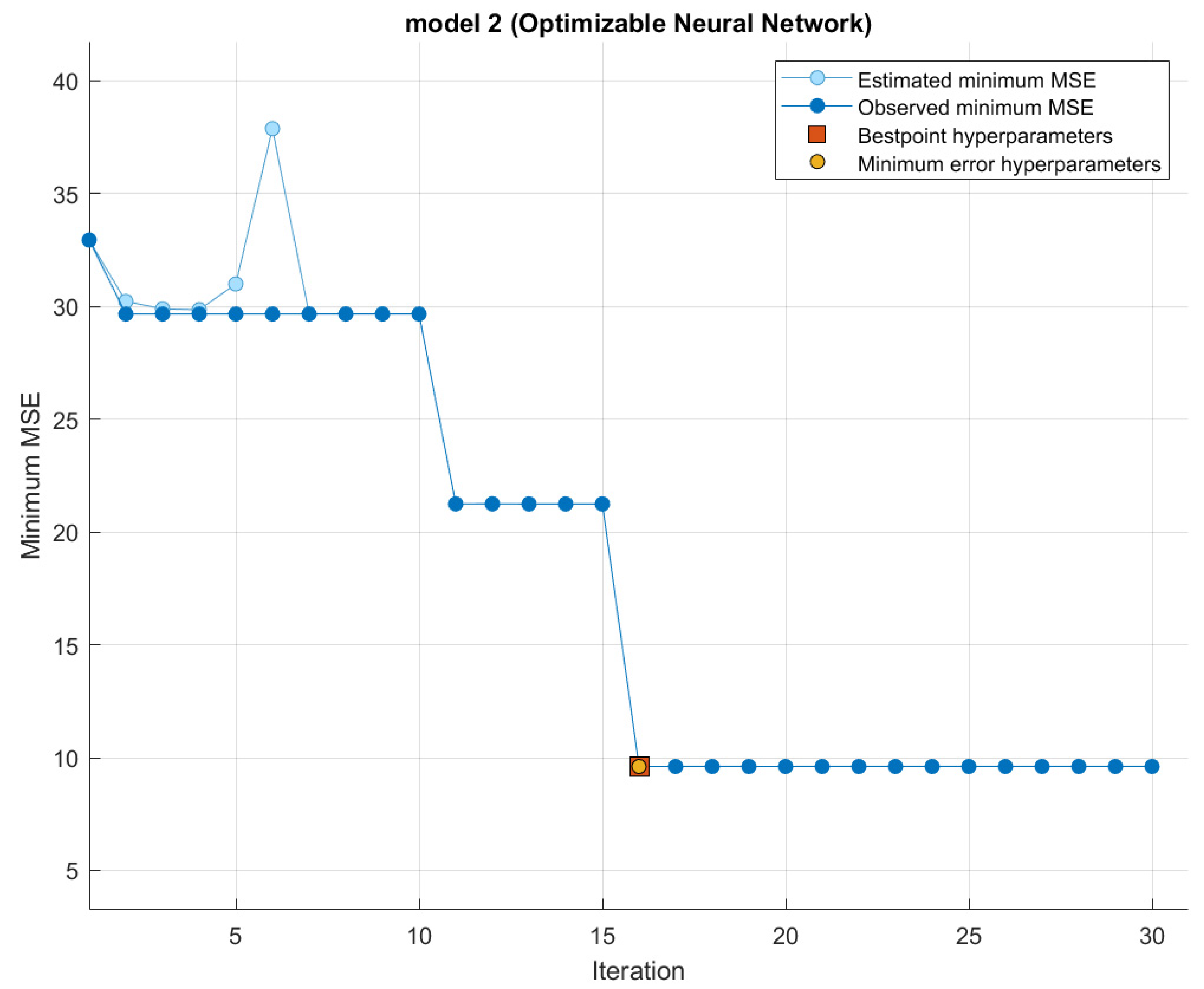
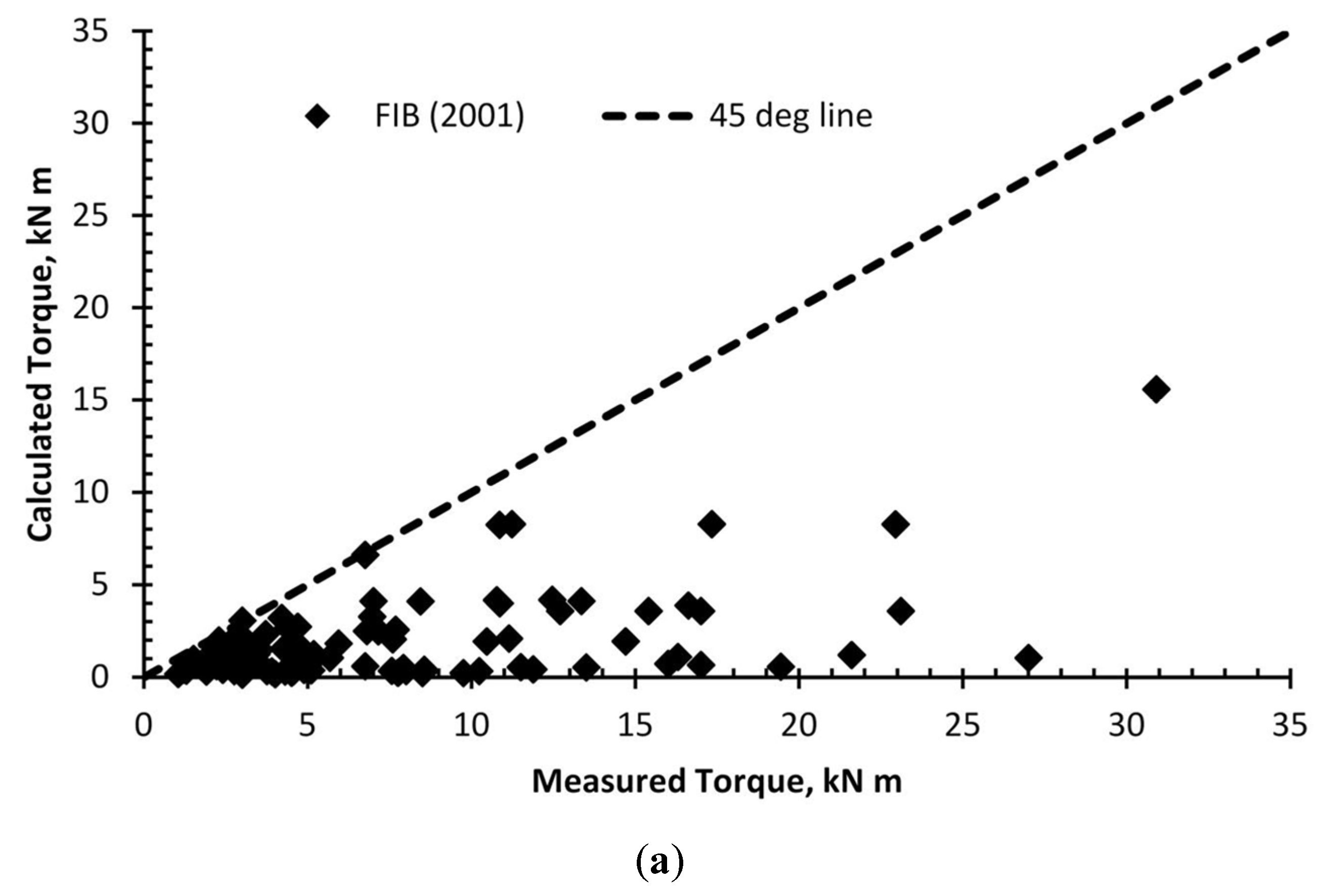
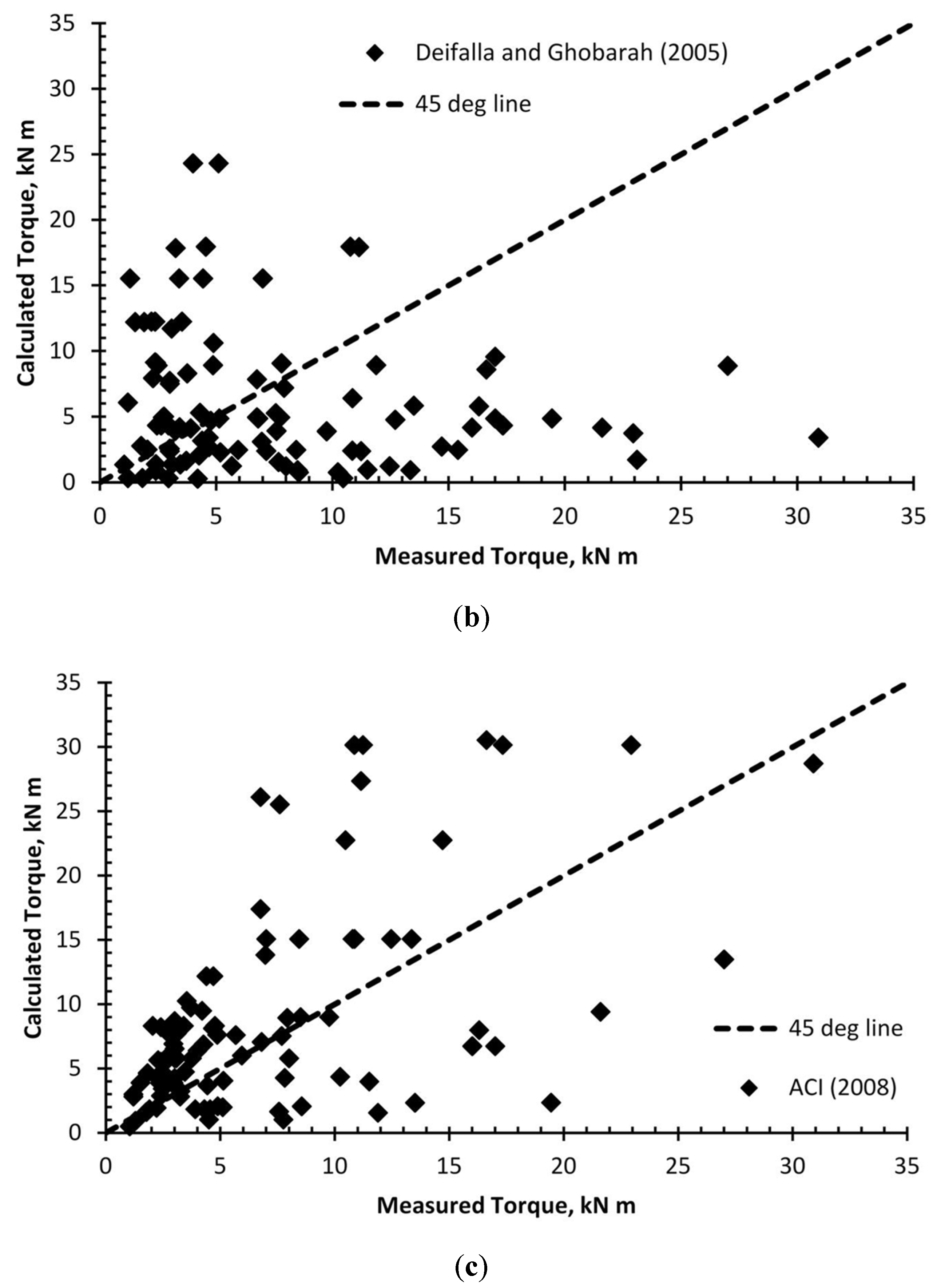
| b | d | E | β | Torsion Gain | |||
|---|---|---|---|---|---|---|---|
| (mm) | (mm) | (MPa) | (%) | (MPa) | (Degrees) | (kN m) | |
| Overall | |||||||
| Min. | 150 | 90 | 61 | 0.09 | 25 | 0 | 1.04 |
| Max. | 400 | 500 | 287 | 1.67 | 80.56 | 90 | 31.05 |
| Avg. | 288 | 155 | 178 | 0.42 | 37.48 | 85 | 8 |
| SD | 74.6 | 48.6 | 80 | 0.39 | 15.70 | 15 | 6 |
| C.O.V. | 26% | 31% | 45% | 92% | 42% | 18% | 85% |
| Training or Testing | Study | No. of Beams | Shape | < 40 | ≥ 40 | h ≤ 400 mm | GFRP | CFRP | Full | U-Jacket | Side | Top or Bottom | Strips | Continuous | β | |||||
|---|---|---|---|---|---|---|---|---|---|---|---|---|---|---|---|---|---|---|---|---|
| Rectangle | T-Shaped | L-Shaped | Hollow | 0 | 45 | 90 | ||||||||||||||
| Data set used for training | [37] | 9 | 9 | - | - | - | 9 | - | 9 | 9 | 7 | - | 2 | 1 | 7 | 3 | - | 7 | ||
| [38] | 4 | 4 | - | - | - | 4 | - | 4 | 4 | 4 | - | - | - | - | 4 | - | - | 4 | ||
| [39] | 8 | 8 | - | - | - | 8 | - | 8 | 2 | 6 | 8 | - | 1 | - | 5 | 2 | - | - | 6 | |
| [40] | 7 | 7 | - | - | - | 7 | - | 7 | 7 | - | 4 | 3 | - | - | 4 | 3 | 5 | - | 2 | |
| [41] | 7 | 7 | - | - | - | 7 | - | 7 | - | 7 | 5 | 2 | - | - | 5 | 2 | 4 | - | 5 | |
| [42] | 1 | 1 | - | - | - | - | - | 1 | - | 1 | 1 | - | - | - | - | 1 | - | - | ||
| [43] | 4 | - | - | 4 | - | 4 | - | 4 | - | - | - | 4 | - | - | - | 4 | 2 | 1 | 3 | |
| [44] | 6 | 6 | - | - | - | 6 | - | 6 | 3 | 3 | 2 | - | 4 | - | 6 | 2 | 5 | |||
| [45] | 6 | 6 | - | - | - | 6 | - | 6 | 6 | 6 | - | - | - | 3 | 3 | - | - | 6 | ||
| [46] | 2 | 2 | - | - | - | 2 | 2 | 2 | 2 | - | - | - | 2 | - | - | - | 2 | |||
| [23,27,28,29] | 4 | - | 4 | - | - | 4 | - | 4 | - | - | 2 | 2 | - | - | - | 4 | - | 4 | - | |
| [46] | 4 | 1 | - | - | 3 | 4 | - | 4 | - | 4 | 4 | - | - | 4 | - | - | - | - | ||
| [47] | 10 | 10 | - | - | 10 | - | 10 | 5 | 5 | 6 | 4 | - | - | 4 | 6 | - | - | 10 | ||
| [48] | 16 | 10 | 3 | 3 | 16 | - | 16 | 14 | 2 | 8 | 8 | - | - | 14 | 2 | 1 | 2 | 14 | ||
| [49] | 8 | 6 | 2 | - | - | 8 | - | 8 | - | 8 | 6 | 2 | - | - | 3 | 5 | - | - | 8 | |
| [50] | 10 | 10 | - | - | - | 10 | 10 | - | 10 | 8 | 2 | - | - | 2 | 8 | - | - | 10 | ||
| [51] | 2 | 2 | - | - | - | 2 | 2 | 2 | - | - | 2 | - | - | 2 | - | - | 2 | |||
| [52] | 7 | 7 | - | - | - | - | 7 | 7 | - | 7 | 6 | 1 | - | - | 2 | 5 | - | - | 7 | |
| [53] | 8 | 8 | - | - | - | 8 | - | 8 | - | 8 | 6 | 2 | - | - | 3 | 5 | - | - | 8 | |
| [54] | 4 | - | 4 | - | - | 3 | - | 3 | 4 | - | 4 | - | - | 4 | - | - | 1 | 3 | ||
| Dataset for testing | [55] | 8 | 8 | - | - | 8 | - | 8 | 8 | 8 | - | - | - | 6 | 2 | - | 2 | 6 | ||
| [22] | 8 | 2 | 2 | 4 | 8 | - | 8 | - | 8 | 3 | 5 | - | - | 8 | - | - | 3 | 5 | ||
| [56] | 7 | - | - | 7 | 7 | - | 7 | - | 7 | 2 | 5 | - | - | 7 | - | - | - | 7 | ||
| [57] | 1 | 1 | - | - | - | 1 | - | 1 | 1 | - | 1 | - | - | - | 1 | - | - | - | 1 | |
| [58] | 6 | 6 | - | - | - | 6 | - | 6 | 6 | - | 6 | - | - | - | 4 | 2 | 1 | 2 | 3 | |
| Number of tested beams | 157 | 121 | 15 | 18 | 3 | 136 | 19 | 156 | 52 | 97 | 105 | 46 | 7 | 1 | 96 | 58 | 18 | 17 | 124 | |
| Percentage (%) | 77 | 10 | 11 | 2 | 87 | 12 | 99 | 33 | 67 | 67 | 29 | 4 | 1 | 61 | 37 | 11 | 11 | 79 | ||
| Study | Anchors | Spacing | Preloading | Plies | Size Effect |
|---|---|---|---|---|---|
| [37] | |||||
| [38] | |||||
| [39] | |||||
| [40] | |||||
| [41] | |||||
| [42] | |||||
| [43] | |||||
| [44] | |||||
| [45] | |||||
| [46] | |||||
| [23,27,29] | |||||
| [46] | |||||
| [47] | |||||
| [48] | |||||
| [49] | |||||
| [50] | |||||
| [51] | |||||
| [52] | |||||
| [53] | |||||
| [54] | |||||
| [55] | |||||
| [22] | |||||
| [56] | |||||
| [57] | |||||
| [58] | |||||
| Number of studies | 7 | 9 | 4 | 12 | 2 |
| Percentage (%) | 28% | 36% | 16% | 48% | 8% |
| b | d | E | β | Torsion Gain | |||
|---|---|---|---|---|---|---|---|
| mm | mm | MPa | (%) | MPa | Degrees | kN m | |
| Training set | |||||||
| Min. | 150 | 90 | 61 | 0.1 | 45 | 25 | 1.04 |
| Max. | 400 | 500 | 287 | 1.7 | 90 | 80.56 | 30.9 |
| Avg. | 297 | 160 | 182 | 0.5 | 87 | 40 | 8 |
| SD | 74 | 53 | 80 | 0.4 | 11 | 17 | 6 |
| C.O.V. | 25% | 33% | 44% | 91% | 13% | 42% | 76% |
| Validation set | |||||||
| Min. | 150 | 90 | 61.58 | 0.09 | 0 | 25 | 1.67 |
| Max. | 400 | 150 | 232 | 0.86 | 90 | 32 | 31.05 |
| Avg. | 258 | 139 | 165 | 0.29 | 79 | 28 | 8 |
| SD | 69 | 17 | 80 | 0.24 | 24 | 3 | 8 |
| C.O.V. | 27% | 12% | 49% | 82% | 30% | 11% | 111% |
| Models | R-Squared | RMSE | MAE | Training Time (s) |
|---|---|---|---|---|
| Ensemble Trees | ||||
| Boosted | 0.71 | 3.4274 | 2.1631 | 2.7569 |
| Bagged | 0.47 | 4.6322 | 3.3205 | 3.1841 |
| Gaussian Process Regression | ||||
| Squared Exponential | 0.93 | 1.6854 | 1.1702 | 5.2342 |
| Marten 5/2 | 0.93 | 1.6778 | 2.8149 | 1.175 |
| Exponential | 0.93 | 1.7447 | 1.1914 | 1.9939 |
| Rational Quadratic | 0.93 | 1.6863 | 1.1523 | 4.8316 |
| Neural Network | ||||
| Narrow | 0.56 | 1.6854 | 2.8724 | 3.1006 |
| Medium | 0.92 | 1.6778 | 1.1643 | 1.175 |
| Wide | 0.93 | 1.6634 | 0.98591 | 7.7472 |
| Bi-layered | 0.71 | 3.4655 | 2.2849 | 2.7611 |
| Tri-layered | 0.92 | 1.8611 | 3.4636 | 3.7419 |
| Models | FIB (2001) | Deifalla and Ghobarah (2005) | ACI (2008) | Wide Neural NetWork Model |
|---|---|---|---|---|
| Average | 8.50 | 2.31 | 1.22 | 1.11 |
| Standard Deviation | 9.48 | 3.58 | 1.53 | 0.40 |
| Maximum | 42.29 | 22.62 | 8.25 | 2.32 |
| Minimum | 0.89 | 0.21 | 0.07 | 0.23 |
| Lower 95% | 6.47 | 1.55 | 0.89 | 1.02 |
| Upper 95% | 10.52 | 3.08 | 1.54 | 1.20 |
Publisher’s Note: MDPI stays neutral with regard to jurisdictional claims in published maps and institutional affiliations. |
© 2022 by the authors. Licensee MDPI, Basel, Switzerland. This article is an open access article distributed under the terms and conditions of the Creative Commons Attribution (CC BY) license (https://creativecommons.org/licenses/by/4.0/).
Share and Cite
Deifalla, A.; Salem, N.M. A Machine Learning Model for Torsion Strength of Externally Bonded FRP-Reinforced Concrete Beams. Polymers 2022, 14, 1824. https://doi.org/10.3390/polym14091824
Deifalla A, Salem NM. A Machine Learning Model for Torsion Strength of Externally Bonded FRP-Reinforced Concrete Beams. Polymers. 2022; 14(9):1824. https://doi.org/10.3390/polym14091824
Chicago/Turabian StyleDeifalla, Ahmed, and Nermin M. Salem. 2022. "A Machine Learning Model for Torsion Strength of Externally Bonded FRP-Reinforced Concrete Beams" Polymers 14, no. 9: 1824. https://doi.org/10.3390/polym14091824







